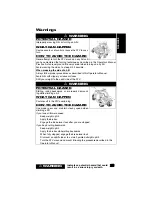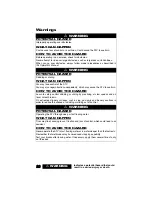
! WARNING
Indicates a potential hazard that could
result in a serious injury or death.
22
Prevention
• Cellular Phone
• Maps/GPS
• Emergency Kit
with Flashlight and
First Aid Kit
Tools
Routine maintenance will generally
eliminate the need for emergency
repairs. Riding on rough terrain could
cause loosening of nuts, bolts, and fas-
teners. Especially on long rides, carry-
ing the right tools can prevent an
inconvenience from becoming a crisis.
Water
Water is so important that you need to
carry it regardless of the duration of
your ride. Heat exhaustion and heat
stroke can creep up suddenly and can
take you out of commission. If you
become dehydrated, you could find
yourself physically unable to safely
operate your ATV.
Identification
If something does happen to you, the
emergency personnel will want to
know who you are and whom to con-
tact. It’s possible you may be in no
condition to give them that informa-
tion. Put your I.D. in your pocket
before you ride. Without it, you’re
anonymous.
Cellular Phone
It may be necessary to make an urgent
phone call.
Maps/GPS (Global
Positioning System)
Maps may be unnecessary when you’re
familiar with the area. But when you’re
riding on unfamiliar trails, it’s good to
know where you are, what’s coming
up, and how to get back.
Emergency Kit with
Flashlight and First Aid
Kit
You’ll need several items in your
Emergency Kit including a flashlight.
The matches will come in handy if you
need to start a fire to stay warm. Flares
are appropriate for signaling help. A
first aid kit is very important if an
injury of some type should happen. A
good First Aid Kit should include ban-
dages, antiseptic spray, gauze, tape, etc.
Carry these items on your ATV:
1. Bulbs
2. Duct tape
3. Rope
4. Spark plugs
5. Spare parts
6. Tool Kit
Carry these items:
1. Flashlight
2. Matches
3. Flares
4. First Aid Kit
5. Money
















































